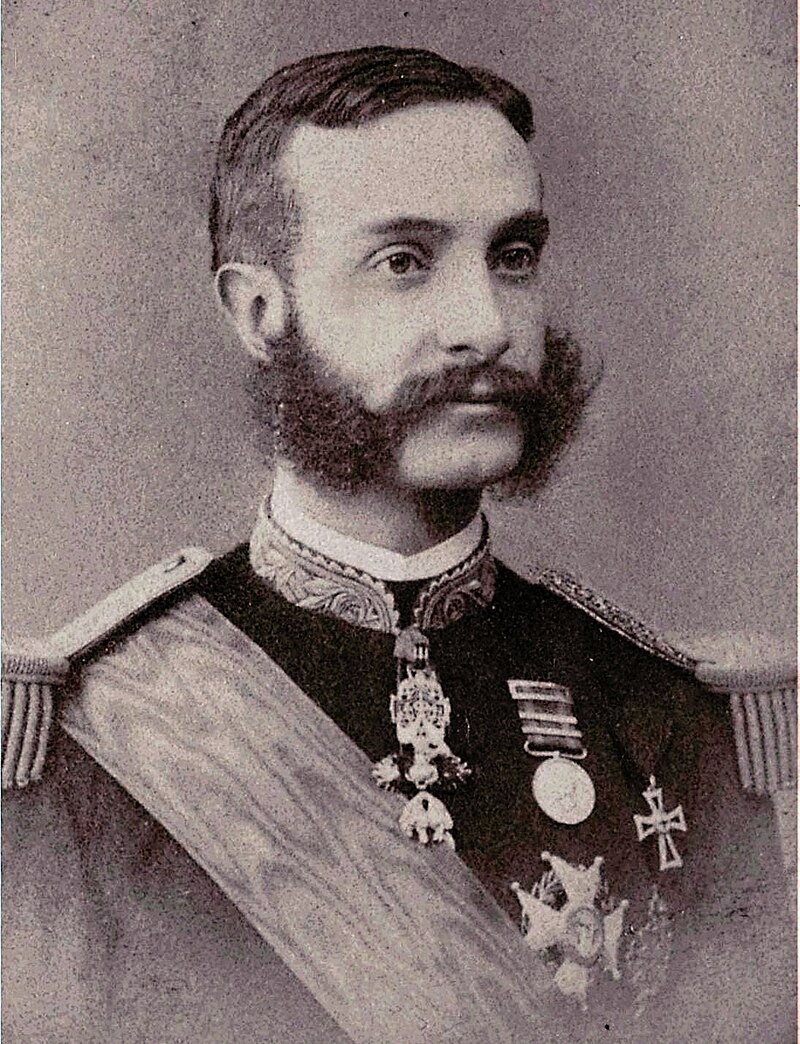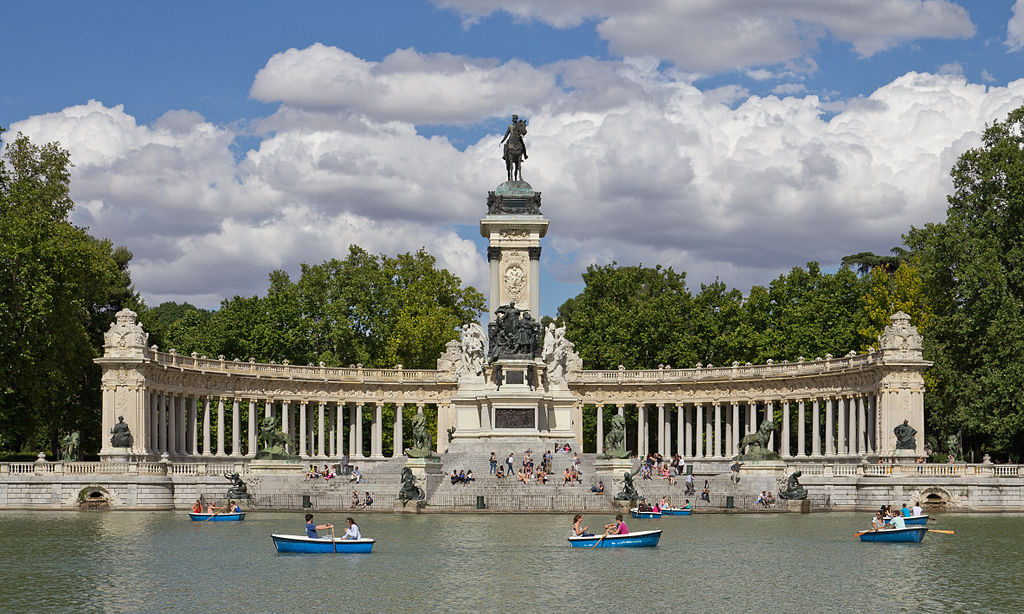by Susan Flantzer
© Unofficial Royalty 2015

King Alfonso XII of Spain; Credit – Wikipedia
Alfonso Francisco de Asís Fernando Pío Juan María de la Concepción Gregorio Pelayo was born as Prince of Asturias, the heir to the Spanish throne, at the Royal Palace in Madrid on November 28, 1857. He was the son of Queen Isabella II of Spain, and officially, Francisco, Duke of Cadiz and King Consort. Rumors circulated that Isabella’s children were not fathered by Francisco due to his suspected homosexuality and that Alfonso’s biological father was Enrique Puigmoltó y Mayans, a captain of the guard.
Alfonso had eight siblings, but only four survived childhood:
- Ferdinand (1850), died at birth
- Isabella (1851–1931), married Prince Gaetan, Count of Girgenti, her mother’s and father’s first cousin, no issue
- Maria Cristina (born and died 1854)
- Maria de la Concepcion (1859–1861), died young
- Maria del Pilar (1861–1879), unmarried
- María de la Paz (1862–1946), married her first cousin Prince Ludwig Ferdinand of Bavaria, had issue
- Francisco de Asis (born and died1863)
- Eulalia (1864–1958), married her first cousin Infante Antonio, Duke of Galliera, had issue
Alfonso was first educated by tutors. He then attended the Collège Stanislas de Paris, the Theresianum in Vienna, Austria and the Royal Military Academy Sandhurst in England.

Alfonso in 1870; Photo Credit – Wikipedia
Queen Isabella II’s authoritarianism, her religious fanaticism, her alliance with the military, and the chaos of her reign — sixty different governments — helped bring about the Revolution of 1868 that exiled her to Paris, France. The new government replaced Isabella with Amadeo I, the second son of Victor Emmanuel II of Italy. During Amadeo’s reign, there were many republican uprisings so he abdicated in 1873 and returned to Italy. The First Spanish Republic was declared but it lasted a little less than two years. Isabella had officially abdicated in 1870 and after the First Spanish Republic collapsed, 17-year-old Alfonso became king on December 29, 1874.
During Alfonso XII’s reign, the monarchy was consolidated and government institutions were stabilized, repairing the damage that the recent internal struggles had left. For this Alfonso earned the nickname “The Peacemaker.” The new Constitution of 1876 was adopted and in the same year the Third Carlist War ended.

Wedding of King Alfonso XII and his first wife Princess Maria de las Mercedes of Orléans; Credit – Wikipedia
On January 23, 1878, at the Royal Basilica of Our Lady of Atocha in Madrid, Alfonso married his first cousin Princess Maria de las Mercedes of Orléans, daughter of Antoine, Duke of Montpensier and his maternal aunt Infanta Luisa Fernanda of Spain. Less than five months later, Mercedes developed typhoid fever and died two days after her 18th birthday, on June 26, 1878. A year later, Alfonso agreed to marry Mercedes’ sister Maria Cristina, but she developed tuberculosis and died during their engagement.
Alfonso married for a second time on November 29, 1879, at the Royal Basilica of Our Lady of Atocha in Madrid. His bride was Archduchess Maria Christina of Austria, daughter of Archduke Karl Ferdinand of Austria and Archduchess Elisabeth Franziska of Austria, and a second cousin of Franz Joseph, Emperor of Austria.
The couple had three children:
- María de las Mercedes (1880 – 1904), married Prince Carlos of Bourbon-Two Sicilies, had issue, died after childbirth
- María Teresa, (1882 – 1912), married Prince Ferdinand of Bavaria, had issue
- King Alfonso XIII (1886 – 1941), born after his father’s death, married Princess Victoria Eugenie of Battenberg, granddaughter of Queen Victoria, had issue

King Alfonso XII and his second wife Archduchess Maria Christina of Austria; Credit – Wikipedia
Alfonso was not faithful to Maria Christina and at the beginning of their marriage, she endured these infidelities. Alfonso had an affair with Italian opera singer Adela Borghi, but his affair with Spanish opera singer Elena Sanz, with whom Alfonso had two children, Alfonso Sanz (1880 – 1970) and Fernand Sanz (1881 – 1925), was the final straw. Maria Christina was finally able to prevail and Elena Sanz had to go into exile in Paris. Competing for the French Olympic Team, Fernand Sanz won a silver medal in cycling at the 1900 Olympics in Paris.
On November 25, 1885, three days before his 28th birthday, King Alfonso XII died from tuberculosis at the Royal Palace of El Pardo in Madrid, leaving two daughters and his queen pregnant with her third child. It was decided that Alfonso’s widow Maria Christina would rule as regent until the child was born. If the child were a male, he would become king and if the child were a female, Alfonso and Maria Christina’s elder daughter María Mercedes would become queen. On May 17, 1886, a son was born who immediately became King Alfonso XIII.

“The Death of Alfonso XII” or “The Last Kiss” by Juan Antonio Benlliure, 1887; Credit – Wikipedia
King Alfonso XII was interred in the Pantheon of Kings in the Royal Crypt of the Monastery of El Escorial.

Tomb of King Alfonso XII (top); Photo Credit – Wikipedia
In 1902, Alfonso’s widow Maria Christina held a national contest for a design to build a monument in memory of King Alfonso XII. Catalan architect José Grases Riera won the contest and his design was built in an artificial lake in Madrid’s Parque del Buen Retiro in 1922.

Monument to King Alfonso XII; Photo Credit – Carlos Delgado, Wikipedia
This article is the intellectual property of Unofficial Royalty and is NOT TO BE COPIED, EDITED, OR POSTED IN ANY FORM ON ANOTHER WEBSITE under any circumstances. It is permissible to use a link that directs to Unofficial Royalty.
Kingdom of Spain Resources at Unofficial Royalty
- Kingdom of Spain Index
- Line of Succession to the Throne of Spain
- Monarchs of a United Spain (since 1516)
- Profiles of the Spanish Royal Family
- Spanish Royal Burial Sites
- Spanish Royal Christenings
- Spanish Royal Dates
- Spanish Royal FAQs
- Spanish Royal Links
- Spanish Royal Weddings
- Spanish Royal Residences
